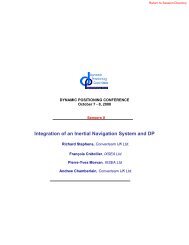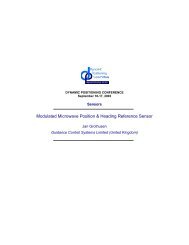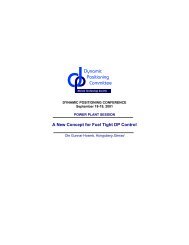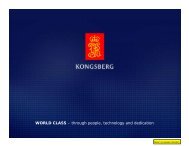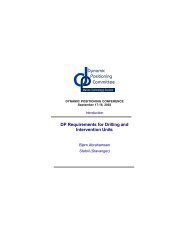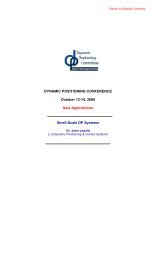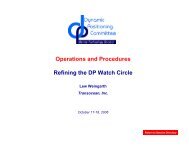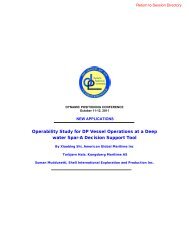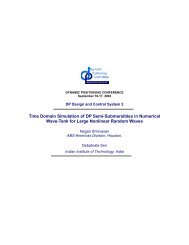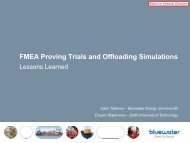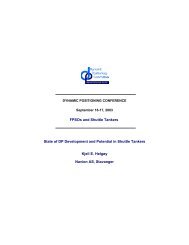Deepwater Field Development - Flow Assurance - Dynamic ...
Deepwater Field Development - Flow Assurance - Dynamic ...
Deepwater Field Development - Flow Assurance - Dynamic ...
You also want an ePaper? Increase the reach of your titles
YUMPU automatically turns print PDFs into web optimized ePapers that Google loves.
DP Conference MTS Symposium<br />
<strong>Flow</strong> <strong>Assurance</strong><br />
Elijah Kempton<br />
Tommy Golczynski<br />
Marine Technology Society<br />
September 30, 2004
Session Outline<br />
•<strong>Flow</strong> <strong>Assurance</strong> Overview<br />
•Key <strong>Flow</strong> <strong>Assurance</strong> Issues<br />
•Wax<br />
•Hydrates<br />
•Slugging<br />
•<strong>Deepwater</strong> Impacts on <strong>Flow</strong> <strong>Assurance</strong><br />
•Emerging Technologies<br />
•Design Considerations<br />
•Black Oil Systems<br />
•Gas Condensate Systems
<strong>Flow</strong> <strong>Assurance</strong> Overview
What is <strong>Flow</strong> <strong>Assurance</strong>?<br />
• Analysis of the entire production system to ensure that<br />
the produced fluids continue to flow throughout the life<br />
of the field.<br />
• Optimization of the design and operating procedures to<br />
cost effectively prevent or mitigate slugging, surge<br />
volumes, wax deposition, gelling, hydrates,<br />
asphaltenes, etc.
Key <strong>Flow</strong> <strong>Assurance</strong> Issues<br />
•Wax (Paraffin) – What is it?<br />
•A solid hydrocarbon which precipitates<br />
from a produced fluid<br />
•Forms when the fluid temperature drops<br />
below the Wax Appearance Temperature<br />
(WAT)<br />
•Melts at elevated temperatures (20°F+<br />
above the WAT)<br />
•Rate of deposition can be predicted for<br />
pigging frequency
Key <strong>Flow</strong> <strong>Assurance</strong> Issues<br />
•Wax<br />
•Since 1996, there have been 51 major<br />
occurrences that the MMS had to be involved in<br />
•All were paraffin-related<br />
•Means of remediation<br />
•Pigging<br />
•Continuous inhibition (150-250 ppm for Gulf of Mexico)<br />
•Reduced wax deposition rate by 60-90%<br />
•Industry Technology<br />
•Modeling is overly-conservative (6X pigging<br />
frequency)
Key <strong>Flow</strong> <strong>Assurance</strong> Issues<br />
Example WAT Measurement<br />
Above WAT<br />
Wax Crystals (WAT)<br />
Seabed Temp. (40°F)
Key <strong>Flow</strong> <strong>Assurance</strong> Issues<br />
•Factors effecting wax deposition rate<br />
•Wax Appearance Temperature, WAT<br />
•Production Fluid Temperature<br />
•<strong>Flow</strong>line U-value<br />
•Fluid Properties<br />
•Viscosity<br />
•N-Paraffin Content
Key <strong>Flow</strong> <strong>Assurance</strong> Issues<br />
•Wax Deposition – Insulation Impact
Key <strong>Flow</strong> <strong>Assurance</strong> Issues<br />
•Hydrate – What is it?<br />
•An Ice-like solid that forms<br />
when:<br />
•Sufficient water is present<br />
•Hydrate former (i.e., methane)<br />
is present<br />
•Right combination of Pressure<br />
and Temperature (High<br />
Pressure / Low Temperature<br />
Molecular<br />
Structure of<br />
Hydrate Crystal
Key <strong>Flow</strong> <strong>Assurance</strong> Issues<br />
•Hydrates<br />
•Primary cause for insulated flowlines<br />
•<strong>Deepwater</strong> operations<br />
•Increased operating pressure<br />
•Cold ambient temperatures<br />
•Means of remediation<br />
•Crude oil displacement (looped flowlines)<br />
•Depressurization<br />
•Coiled tubing<br />
•Continuous Inhibition (Prevention Only)<br />
•Methanol/MEG<br />
•LDHI
Key <strong>Flow</strong> <strong>Assurance</strong> Issues<br />
•Hydrates – Base Information<br />
10000<br />
9000<br />
8000<br />
7000<br />
Pressure, psia<br />
6000<br />
5000<br />
4000<br />
Hydrates<br />
No<br />
Hydrates<br />
3000<br />
2000<br />
Pure Water<br />
Sea Water<br />
1000<br />
Produced Water<br />
0<br />
40 45 50 55 60 65 70 75 80 85<br />
Temperature, °F
Key <strong>Flow</strong> <strong>Assurance</strong> Issues<br />
•Hydrates – Base Information<br />
Methanol Dosage, Methanol BBL MeOH/BBL Rate, gpm Water<br />
50<br />
0.600<br />
45<br />
0.575<br />
0.550 40<br />
0.525 35<br />
0.500<br />
30<br />
0.475<br />
25<br />
0.450<br />
20<br />
0.425<br />
0.400 15<br />
0.375<br />
10<br />
5% Water Cut<br />
10% Water Cut<br />
20% Water Cut<br />
25% Water Cut<br />
30% Water Cut<br />
40% Water Cut<br />
50% Water Cut<br />
25 GPM<br />
0.350<br />
761 GOR 1100 GOR<br />
5<br />
0.325<br />
1700 GOR 2500 GOR<br />
0<br />
0.300<br />
1000 2000 3000 4000 5000 6000 7000 8000 9000 10000<br />
50 75 100 125 150 175 200 225 250 275 300<br />
Shut-in <strong>Flow</strong>rate, Pressure, B/d bara
Key <strong>Flow</strong> <strong>Assurance</strong> Issues<br />
•Slugging – What is it?<br />
•Periods of Low <strong>Flow</strong><br />
Followed by Periods of<br />
High <strong>Flow</strong><br />
•Occurs in Multiphase<br />
<strong>Flow</strong>lines at Low Gas<br />
Velocities
Key <strong>Flow</strong> <strong>Assurance</strong> Issues<br />
•Slugging<br />
•Causes<br />
•Low fluid velocity<br />
•Bigger ≠ Better<br />
•Seabed bathymetry (downsloping)<br />
•Riser type<br />
•“Lazy-S” is a slug generator<br />
•Means of prevention<br />
•Increase flowrate<br />
•Separator pressure<br />
•Gas lift<br />
Advantages<br />
Proven<br />
Technology<br />
Relative<br />
Inexpensive<br />
Gas Lift<br />
Overview<br />
Disadvantages<br />
Erosion<br />
Concerns<br />
Lower<br />
Temperatures<br />
Difficult with<br />
Catenary Risers
Key <strong>Flow</strong> <strong>Assurance</strong> Issues<br />
•Slugging – Gas Lift Impacts<br />
Liquid Liquid Accumulation Outlet <strong>Flow</strong>rate Above (B/d)<br />
Normal (bbl)<br />
150<br />
40000 25000<br />
60000<br />
35000 100<br />
50000<br />
20000<br />
30000<br />
50<br />
40000<br />
25000<br />
15000<br />
0<br />
20000 30000<br />
10000<br />
15000 -50<br />
20000<br />
10000<br />
-100 5000<br />
10000<br />
5000<br />
5 MMSCFD 010 Gas MMSCFD Surge<br />
MMSCFD LiftVolume<br />
Gas Gas Lift Lift<br />
0 MMSCFD Gas Lift<br />
5 MMSCFD Gas Lift<br />
10 MMSCFD Gas Lift<br />
-150<br />
3.0 0<br />
3.5 4.0 4.5 5.0 5.5 6.0 6.5 7.0 7.5 8.0<br />
3.0 3.5 4.0 4.5 5.0 Time<br />
5.5<br />
(hours)<br />
6.0 6.5 6.5 7.0 7.0 7.5 7.5 8.0 8.0<br />
Time (hours)
Key <strong>Flow</strong> <strong>Assurance</strong> Issues<br />
•Other Issues<br />
Chemical Inventory<br />
Asphaltenes<br />
Pour Point<br />
Corrosion<br />
Scale<br />
Flare Capacity<br />
Emulsions<br />
C-Factors<br />
Cooldown Times<br />
Surge Volume<br />
Sand<br />
Liquids Management<br />
Erosion<br />
Depressurization Pigging
<strong>Deepwater</strong> Impacts on <strong>Flow</strong><br />
<strong>Assurance</strong><br />
•Hydrate Formation/Wax Deposition<br />
•Leads to:<br />
•Insulation / dual flowlines<br />
•Dry oil flushing<br />
•Active heating<br />
•Chemicals<br />
•Revamped operating strategies<br />
•Lack of pressure / need for boosting<br />
•<strong>Deepwater</strong> + high water cut + long tiebacks<br />
•Riser base gas lift<br />
•Multiphase pumping<br />
•Subsea separation
<strong>Deepwater</strong>:<br />
Temperature Losses<br />
• Potential Energy Losses<br />
• Gas does “work” in moving fluids<br />
• Function of water depth<br />
• Expansion Cooling (Joule-Thomson Effect)<br />
• Exacerbated at large pressure differentials<br />
• RISER DOMINATES DEEPWATER SYSTEMS<br />
• Insulation may not be the answer!
<strong>Deepwater</strong>:<br />
125<br />
Temperature Losses<br />
120<br />
FLOWLINE<br />
WELLHEAD<br />
RISER BASE<br />
115<br />
Temperature (°F)<br />
110<br />
105<br />
100<br />
Potential Energy<br />
(Work)<br />
48%<br />
Surroundings<br />
(U-Value)<br />
6%<br />
RISER<br />
Joule-Thomson<br />
Cooling<br />
46%<br />
TOPSIDES<br />
95<br />
0 1 2 3 4 5 6 7 8<br />
Distance (miles)
<strong>Deepwater</strong>:<br />
Temperature Losses<br />
<strong>Flow</strong>line<br />
Temperature Drop (°F)<br />
Length<br />
(miles)<br />
3<br />
<strong>Flow</strong>line<br />
1.2<br />
Riser<br />
16.6<br />
6<br />
2.9<br />
16.6<br />
15<br />
9.2<br />
16.5
• Heat transfer coefficient (U-value) dictates<br />
steady state temperatures<br />
• Q (heat loss) = U•A•∆T<br />
• U-Value ↓, Q ↓ …T ↑<br />
• Thermal mass (ρ, Cp) impacts transient<br />
performance<br />
• Measure of heat storage<br />
• Prolongs cooldown times<br />
• Prolongs warm-up times<br />
<strong>Deepwater</strong>:<br />
Temperature Losses
Transient Temperature Loss<br />
110<br />
100<br />
90<br />
Temperature (°F)<br />
80<br />
70<br />
60<br />
HIGH (Gelled Fluid #2 – Water Base)<br />
MEDIUM (Gelled Fluid #1 – Oil Base)<br />
50<br />
LOW (Nitrogen)<br />
40<br />
0 5 10 15 20 25 30 35 40<br />
Time(hours)
<strong>Deepwater</strong>:<br />
Pressure Losses<br />
2500<br />
WELLHEAD<br />
2000<br />
FLOWLINE<br />
RISER BASE<br />
1500<br />
Pressure (psia)<br />
1000<br />
RISER<br />
500<br />
0<br />
0 1 2 3 4 5 6 7 8<br />
Distance (miles)<br />
TOPSIDES
<strong>Deepwater</strong>:<br />
Pressure Losses<br />
<strong>Flow</strong>line<br />
Pressure Drop (psia)<br />
Length<br />
(miles)<br />
3<br />
<strong>Flow</strong>line<br />
143<br />
Riser<br />
1812<br />
6<br />
238<br />
1791<br />
15<br />
405<br />
1764
<strong>Deepwater</strong>:<br />
Dry Trees vs. Subsea Tieback<br />
• Dry trees preferred for accessibility<br />
• Dry trees more difficult for flow assurance<br />
• Typically cannot depressurize<br />
• Short cooldown times (2-8 hours)<br />
• Fewer insulation/heating options than subsea<br />
• Limited chemical (MeOH/MEG) deliverability<br />
• Wax deposition more difficult to remediate
Dry Tree:<br />
Conduction / Convection / Radiation<br />
100<br />
Dry Tree Analysis: Cooldown Comparison<br />
Production Fluid Temperature<br />
95<br />
90<br />
85<br />
80<br />
Temperature (°F)<br />
75<br />
70<br />
65<br />
60<br />
HYDRATE FORMATION TEMPERATURE<br />
55<br />
50<br />
45<br />
Solid - Conduction<br />
Liquid - Conduction+Convection<br />
Gas - Conduction+Convection+Radiation<br />
40<br />
0 1 2 3 4 5 6 7 8 9 10 11 12<br />
Time (Hours)
Dry Tree:<br />
Concentric vs. Non-Concentric<br />
• Accommodate Auxiliary Lines?<br />
Concentric<br />
Non-Concentric<br />
• Heat Transfer: Q = k·A·∆T / L<br />
(Conduction Only)
Dry Tree:<br />
Concentric vs. Non-Concentric
Dry Tree:<br />
Gas Properties<br />
100<br />
90<br />
80<br />
Temperature (°F)<br />
70<br />
60<br />
15 psia N2<br />
50<br />
30 psia N2<br />
59 psia N2<br />
102 psia N2<br />
40<br />
0.0 0.5 1.0 1.5 2.0 2.5 3.0 3.5 4.0 4.5 5.0 5.5 6.0<br />
Time (Hours)
Design for Expansion<br />
• Transient issues drive deepwater design<br />
• Cooldown / restart - Hydrates<br />
• Typical deepwater practice<br />
• Dual flowlines / crude oil displacement<br />
• Typically cannot depressurize (oil systems)<br />
• Consider potential for future expansion<br />
• Insulation<br />
• Topsides facilities
Design for Expansion<br />
22.5 km<br />
10 km<br />
8 km 8 km<br />
Total Time to Displace Existing System = 22 Hours (Sequential)<br />
Total Time to Displace Integrated System = 45 Hours (Sequential)<br />
High Level Insulation, or Additional Topsides Facilities Required!
Emerging Technologies<br />
• Artificial Lift<br />
• Subsea Separation (-)<br />
• Multiphase Pumping (+)<br />
• Gas Lift (+ / -)<br />
• Passive Insulation Solutions<br />
• Microporous Insulation<br />
• Phase Change Materials
Emerging Technologies<br />
• Active Heating<br />
• Hot Water Circulation<br />
• Electrically Heated<br />
• “Electrically-heated ready”<br />
• Chemicals<br />
• Low Dosage Hydrate Inhibitors<br />
• “Cold <strong>Flow</strong>”
Design Considerations:<br />
Black Oil and<br />
Gas Condensate Systems
Black Oil System:<br />
Steady State Design Checklist<br />
• Hydraulics<br />
• Line sizing<br />
• Dry tree vs. subsea tieback<br />
• Single vs. dual flowlines<br />
• Dual flowlines becoming “standard” for deepwater<br />
• Pressure drop<br />
• Velocity / erosion (minimum / maximum)<br />
• Slugging<br />
• Thermal<br />
• Insulation requirements<br />
• Hydrate formation<br />
• Wax deposition<br />
• Gel formation
Black Oil System:<br />
Transient Design Checklist<br />
• Shutdown<br />
• Planned<br />
• Unplanned<br />
• Depressurization<br />
• Restart<br />
• Warm<br />
• Cold<br />
• Fluid displacement / pigging<br />
• <strong>Flow</strong>line preheating
Black Oil Systems:<br />
Steady State Design Considerations
Black Oil System:<br />
Steady State Hydraulics<br />
• Pressure drop effects<br />
• Physical<br />
• Line size<br />
• Tieback distance<br />
• Water depth<br />
• Multiphase flow:<br />
Head losses head gains<br />
• Pipe roughness (typical values)<br />
• Steel: 0.0018”<br />
• Tubing: 0.0006”<br />
• Flexible pipe: ID/250<br />
• Fluid properties<br />
• Gas/oil ratio (GOR)<br />
• Density<br />
• Viscosity<br />
• May require insulation to limit viscosity<br />
Pressure (psia)<br />
2500<br />
2000<br />
1500<br />
1000<br />
500<br />
0<br />
0 1 2 3 4 5 6 7 8<br />
Distance (miles)
Black Oil System: Slugging<br />
• Hydrodynamic<br />
• High frequency<br />
• Minimal facilities impact<br />
7<br />
6<br />
5<br />
4<br />
Hydrodynamic Slugging<br />
Gas Outlet <strong>Flow</strong><br />
3<br />
2<br />
1<br />
• Terrain<br />
• High liquid / gas flowrates<br />
• Topsides concern<br />
• Riser fatigue concern<br />
• Utilize gas lift<br />
0<br />
1.0 1.5 2.0 2.5 3.0 3.5 4.0 4.5 5.0 5.5 6.0<br />
80000<br />
70000<br />
60000<br />
50000<br />
40000<br />
30000<br />
20000<br />
Time (hours)<br />
Terrain Slugging<br />
Liquid Outlet <strong>Flow</strong><br />
10000<br />
0<br />
1.0 1.5 2.0 2.5 3.0 3.5 4.0 4.5 5.0 5.5 6.0<br />
Time (hours)
Black Oil System: Slugging<br />
• Slugging issues<br />
• Sensitivity to Fluid GOR / water cut<br />
Water Cut (%)<br />
0<br />
20<br />
40<br />
60<br />
80<br />
Terrain Slugging Regime (BPD) /<br />
Surge Volume (BBL)<br />
760 GOR 1300 GOR 1800 GOR<br />
15000 / 150 12500 / 100 7500 / 75<br />
20000 / 160 17500 / 100 15000 / 125<br />
24000 / 175 20000 / 125 15000 / 130<br />
26000 / 325 17500 / 250 10000 / 200<br />
DNF 5000 / 400 5000 / 300
Black Oil System: Slugging<br />
• Slugging issues<br />
• Sensitivity to Trajectory: up vs. downslope<br />
-7500<br />
-7600<br />
-7700<br />
Original Route - 40 miles total length<br />
Alternate Route #1 - 36 miles total length<br />
Alternate Route #2 - 45 miles total length<br />
-7800<br />
-7900<br />
Water Depth, ft<br />
-8000<br />
-8100<br />
-8200<br />
400<br />
350<br />
Original Route<br />
Alternate Route #1<br />
Alternate Route #2<br />
WELLHEAD<br />
RISER BASE<br />
-8300<br />
-8400<br />
-8500<br />
-8600<br />
0 2 4 6 8 10 12 14 16 18 20 22 24 26 28 30 32 34 36 38 40<br />
Distance, miles<br />
Liquid Accumulation Above Normal* (bbl)<br />
300<br />
250<br />
200<br />
150<br />
100<br />
>24 hour Ramp-up Required<br />
10 hour Ramp-up Required<br />
50<br />
50 bbl Slug Catcher Capacity<br />
0<br />
0 1 2 3 4 5 6 7 8<br />
Time (hours)
Black Oil System:<br />
Steady State Thermal Design<br />
• Hydrates<br />
• Maintain steady state temperature<br />
above hydrate formation region,<br />
down to “reasonable” flowrate<br />
• Looped flowline ~ 25% of field<br />
production (50% per flowline)<br />
• For low water-cut systems,<br />
continuous hydrate inhibition is<br />
possible<br />
• Future: continuous LDHI inhibition
• Wax<br />
Black Oil System:<br />
Steady State Thermal Design<br />
• Maintain temperature above WAT (stock<br />
tank), down to “reasonable” flowrate<br />
• Looped flowline ~ 25% of field production<br />
(50% per flowline)<br />
• Maintain viscosity at acceptable levels to<br />
reduce pressure drop<br />
• Insulate to minimize pigging frequency<br />
• Pigging frequency > residence time<br />
• Continuous paraffin inhibition (if<br />
necessary)
Black Oil System:<br />
Steady State Thermal Design<br />
Insulation Option<br />
Flexible<br />
Wet (Syntactic)<br />
Burial<br />
Pipe-in-pipe<br />
Micro-porous<br />
Achievable U-value<br />
(BTU/hr-ft²-°F)<br />
0.75 – 1.50<br />
0.50 – 0.75<br />
0.50 – 1.00<br />
0.20 – 0.25<br />
0.08 – 0.10<br />
Issue / Concern<br />
•Limited insulating capacity<br />
•Buoyancy issues<br />
•Dependant on soil properties<br />
•Combined with insulation<br />
•Riser installation difficulties<br />
•Industry acceptance
Black Oil System:<br />
Steady State Thermal Design<br />
50.0<br />
Arrival Temperature<br />
Water Cut = 0%<br />
Arrival temperature (°C)<br />
48.0<br />
46.0<br />
44.0<br />
42.0<br />
40.0<br />
38.0<br />
36.0<br />
34.0<br />
32.0<br />
30.0<br />
Adiabatic (0 BTU/ft² hr ºF)<br />
0.09 BTU/ft² hr ºF<br />
0.20 BTU/ft² hr ºF<br />
0.30 BTU/ft² hr ºF<br />
0.50 BTU/ft² hr ºF<br />
28.0<br />
26.0<br />
24.0<br />
22.0<br />
0.5 W/m².K<br />
1.0 W/m².K<br />
2 W/m².K<br />
3.0 W/m².K<br />
no heat loss<br />
20.0<br />
7500 10000 12500 15000 17500 20000 22500 25000 27500 30000 32500 35000 37500 40000<br />
Liquid <strong>Flow</strong>rate (blpd)
Black Oil Systems:<br />
Cooldown Design Considerations
Black Oil System:<br />
Cooldown<br />
• Shutdown statistics<br />
• Typical shutdown durations<br />
• 89% shutdowns < 10 hours<br />
• 94% shutdowns < 12 hours<br />
• 99.9% shutdowns < 24 hours<br />
• Typical shutdown causes<br />
Pumps<br />
Scale<br />
Corrosion<br />
Sand<br />
Paraffin<br />
Hydrates<br />
Asphaltenes<br />
Separation<br />
Other
Black Oil System: Cooldown<br />
• Planned shutdown Procedure<br />
• Inject hydrate inhibitor for one residence time<br />
(minimum)<br />
• At high water cuts, may need to reduce flowrate to<br />
effectively treat system<br />
• Inject hydrate inhibitor into subsea equipment<br />
• Particular attention to horizontal components<br />
• Self-draining manifold / jumpers<br />
• Treat upper portion of wellbore<br />
• SCSSV vs. top ~50 ft<br />
• Shut-in system
Black Oil System:<br />
Cooldown<br />
• Unplanned shutdown Procedure<br />
• Determine minimum cooldown times<br />
• “No-Touch Time”<br />
• ~2-4 hours / no action taken subsea<br />
• “Light Touch Time”<br />
• ~2-4 hours / treat critical components<br />
• Time is a function of chemical injection philosophy / number of wells<br />
• “Preservation Time”<br />
• Time required to depressurize or displace flowlines with non-hydrate<br />
forming fluid<br />
Time=0<br />
Time=4<br />
Time=8<br />
“No-Touch” “Light Touch” “Preservation”
Black Oil System:<br />
Cooldown<br />
• Insulation selection<br />
• Cooldown time determined<br />
by:<br />
• U-Value<br />
• Thermal mass (ρ, Cp)<br />
• Measure of heat<br />
storage<br />
• Line size impacts<br />
• Bigger = More<br />
Thermal Mass<br />
• Gas / liquid interface<br />
typically controlling point<br />
• Gas = low thermal mass<br />
• Highest pressure<br />
• Coldest temperature<br />
Temperature (F)<br />
150<br />
Pipe-in-Pipe (0.20 BTU/hr-ft²-F)<br />
140<br />
Wet Insulation (0.75 BTU/hr-ft²-F)<br />
130<br />
Flexible Pipe (1.00 BTU/hr-ft²-F)<br />
120<br />
110<br />
100<br />
90<br />
80<br />
70<br />
60<br />
HYDRATE FORMATION (PURE WATER)<br />
50<br />
40<br />
0 2 4 6 8 10 12 14 16 18 20 22 24 26 28 30 32 34 36<br />
Time (hours)
Black Oil System: Cooldown<br />
140<br />
0 hours (Steady State)<br />
130<br />
120<br />
110<br />
RESERVOIR<br />
WELLHEAD<br />
FLOWLINE<br />
1 hours<br />
2 hours<br />
4 hours<br />
6 hours<br />
8 hours<br />
10 hours<br />
100<br />
12 hours<br />
18 hours<br />
Temperature (F)<br />
90<br />
80<br />
24 hours<br />
70<br />
60<br />
50<br />
40<br />
RISER<br />
30<br />
0.0 0.5 1.0 1.5 2.0 2.5 3.0 3.5 4.0 4.5 5.0 5.5 6.0<br />
Distance (miles)
Black Oil System: Cooldown<br />
6000<br />
5500<br />
5000<br />
RESERVOIR<br />
0 hours (Steady State)<br />
24 hours<br />
4500<br />
4000<br />
WELLHEAD<br />
Pressure (psia)<br />
3500<br />
3000<br />
2500<br />
2000<br />
FLOWLINE<br />
1500<br />
RISER<br />
1000<br />
500<br />
0<br />
0.0 0.5 1.0 1.5 2.0 2.5 3.0 3.5 4.0 4.5 5.0 5.5 6.0<br />
Distance (miles)
Black Oil System: Cooldown<br />
1.0<br />
0.9<br />
RESERVOIR<br />
WELLHEAD<br />
FLOWLINE<br />
0.8<br />
0.7<br />
Liquid Holdup (-)<br />
0.6<br />
0.5<br />
0.4<br />
0.3<br />
0.2<br />
0.1<br />
0 hours (Steady State)<br />
RISER<br />
24 hours<br />
0.0<br />
0.0 0.5 1.0 1.5 2.0 2.5 3.0 3.5 4.0 4.5 5.0 5.5 6.0<br />
Distance (miles)
Black Oil System: Cooldown<br />
60<br />
WELLHEAD<br />
50<br />
RESERVOIR<br />
FLOWLINE<br />
40<br />
Hydrate Propensity, T-Thyd (F)<br />
30<br />
20<br />
10<br />
0 hours (Steady State)<br />
1 hours<br />
0 2 hours<br />
4 hours<br />
6 hours<br />
-10<br />
8 hours<br />
10 hours<br />
-20<br />
12 hours<br />
18 hours<br />
RISER<br />
24 hours<br />
-30<br />
0.0 0.5 1.0 1.5 2.0 2.5 3.0 3.5 4.0 4.5 5.0 5.5 6.0<br />
Distance (miles)
Black Oil System:<br />
Cooldown Checklist<br />
• Is there adequate chemical injection to treat subsea components within<br />
cooldown time?<br />
• Wellbore<br />
• Trees<br />
• Jumpers<br />
• Manifolds<br />
• What is the subsea valve closure philosophy?<br />
• Packed: More liquid / higher pressures<br />
• Un-packed: Less liquid / lower pressures<br />
• Does insulation provide sufficient cooldown time?<br />
• No-touch<br />
• Light-touch<br />
• Preservation<br />
• Is gel formation a possibility?<br />
• If yes, system design philosophy changes<br />
• Is SCSSV set deep enough to avoid hydrates?
Black Oil Systems:<br />
Depressurization Design<br />
Considerations
Black Oil System: Depressurization<br />
• Hydrate remediation strategy<br />
• Reduce pressure below hydrate formation pressure at seabed<br />
• Effectiveness based on:<br />
• Fluid properties<br />
• GOR<br />
• Water cut<br />
• Seabed bathymetry<br />
• Upslope<br />
• Downslope<br />
• <strong>Deepwater</strong> issues<br />
10000<br />
9000<br />
8000<br />
7000<br />
6000<br />
5000<br />
4000<br />
3000 Phyd ~ 200 psia<br />
Pure Water<br />
2000<br />
Sea Water<br />
1000<br />
Produced Water<br />
0<br />
40 45 50 55 60 65 70 75 80 85<br />
Temperature, °F<br />
• Reduce pressure to ~200 psia at seabed<br />
Time=0<br />
• Maintain pressure below hydrate conditions during restart<br />
Time=4<br />
Time=8<br />
Pressure, psia<br />
“No-Touch”<br />
“Light Touch”<br />
“Preservation”:<br />
Depressurization
Depressurization:Subsea Tieback<br />
4500<br />
4000<br />
BOTTOM HOLE<br />
3500<br />
3000<br />
2500<br />
FLOWLINE<br />
0.0 hours<br />
0.5 hours<br />
1.0 hours<br />
Pressure (psia)<br />
2000<br />
1500<br />
1000<br />
MUDLINE<br />
500<br />
RISER BASE<br />
0<br />
0 1 2 3 4 5 6 7 8 9<br />
Distance (miles)
Depressurization – Dry Tree<br />
4500<br />
4000<br />
3500<br />
3000<br />
BOTTOM HOLE<br />
0.0 hours<br />
0.5 hours<br />
1.0 hours<br />
Pressure (psia)<br />
2500<br />
2000<br />
1500<br />
1000<br />
SCSSV<br />
MUDLINE<br />
500<br />
GAS/LIQUID<br />
INTERFACE<br />
0<br />
0 2000 4000 6000 8000 10000 12000<br />
Distance (feet)
Black Oil System:<br />
Depressurization Checklist<br />
• Can you depressurize below hydrate formation conditions?<br />
• If YES, can you depressurize in late-life at high water cuts?<br />
• If YES, can you maintain pressure below hydrate formation conditions<br />
during restart?<br />
• Difficult for deepwater<br />
• If YES, is there a pour point concern?<br />
• Depressurization increases restart pressure requirements<br />
• If NO, consider the following for hydrate prevention:<br />
• Displacement (dual flowlines)<br />
• Active heating<br />
• Continuous chemical inhibition
Black Oil Systems:<br />
Displacement Design<br />
Considerations
• During “Prevention” time, displace produced<br />
fluids from flowline<br />
Time=0<br />
Black Oil System: Displacement<br />
Hydrate Prevention - Shutdown<br />
• Unable to get hydrate inhibitor to in-situ fluids<br />
during shutdown<br />
• Dual flowlines required<br />
• Sufficient insulation / cooldown time<br />
• Function of flowline length<br />
Time=4<br />
Time=8<br />
“No-Touch”<br />
“Light Touch”<br />
“Preservation”:<br />
Displacement
Black Oil System: Displacement<br />
Discharge Pressure Required<br />
HOLD BACKPRESSURE AT OUTLET
Black Oil System: Displacement<br />
Hydrate Prevention - Shutdown<br />
1800<br />
Dead Oil Flushing - Year 5<br />
FPSO Pump Discharge Pressure<br />
FPSO Arrival Pressure Controlled at 1500 psia<br />
1600<br />
1400<br />
Produced fluids move<br />
up second riser<br />
Gas breaks<br />
through<br />
second riser<br />
1200<br />
Pig moves up<br />
second riser<br />
1000<br />
800<br />
600<br />
400<br />
200<br />
Pig reaches base of first riser<br />
0<br />
0 0.5 1 1.5 2 2.5 3 3.5<br />
Time (H)
Black Oil System: Displacement<br />
Hydrate Prevention - Shutdown<br />
• During “Prevention” time, displace produced fluids<br />
from flowline<br />
• Topsides design considerations<br />
• Available backpressure<br />
• Circulation rate<br />
• Limited by pig integrity<br />
• Typically 3-5 ft/sec<br />
• May be faster for “straight-pipe”<br />
• Storage volume<br />
• Circulation passes<br />
• With pig: 1 residence time<br />
• Without pig: 2-3 residence times for efficient water removal
Black Oil System: Displacement<br />
Hydrate Prevention – Dry Tree<br />
• During shutdown, how quickly will fluids fall below<br />
SCSSV?<br />
• Very little work done with L/D ratios >100 (deepwater riser<br />
~10000)<br />
• <strong>Field</strong> data shows oil/water separation ~ 70-80 ft/hr<br />
• Bullhead / displace with non-hydrate forming<br />
chemical to SCSSV<br />
• Methanol/MEG (volume concerns)<br />
• Heavy diesel (high density, by-pass produced fluids)<br />
• Dead oil<br />
• Ability to bullhead a function of displacement rate
• Is there sufficient time to accomplish displacement<br />
operation?<br />
• Sufficient insulation / Cooldown time<br />
• Is the topsides facility designed to accomplish displacement<br />
operation?<br />
• Pump capacity<br />
• Storage capacity<br />
Black Oil System:<br />
Displacement Checklist<br />
• Can system be restarted into crude-oil filled flowline?<br />
• Displace with gas?<br />
• High pour point fluids – what is the restart pressure required?<br />
• For dry trees, is a proper fluid available for displacement?
Black Oil Systems:<br />
Restart Design Considerations
Black Oil System: Cold Restart<br />
• System pressure < hydrate formation conditions throughout<br />
restart?<br />
• For deepwater, hydrostatic pressure in riser too high<br />
• Separator pressure: may need alternate start-up vessel<br />
• Hydrate inhibition required until arrival temperature reaches<br />
“Safe Operating Temperature” (SOT)<br />
• Maintain hydrate inhibitor rate: Fluid completely inhibited<br />
• Reduce hydrate inhibitor rate: Fluid not completely inhibited to<br />
shut-in conditions<br />
• SOT is minimum topsides temperature that provides<br />
sufficient cooldown time, in the event of an interrupted restart
Black Oil System: Cold Restart<br />
0.60<br />
0.55<br />
Methanol Dosage, BBL MeOH/BBL H2O<br />
0.50<br />
0.45<br />
0.40<br />
0.35<br />
0.30<br />
PURE WATER<br />
1000 1200 1400 1600 1800 2000 2200 2400 2600 2800 3000<br />
Shut-in Pressure, psia<br />
SEA WATER<br />
PRODUCED<br />
WATER
Black Oil System: Cold Restart<br />
50<br />
45<br />
40<br />
75% WATER<br />
50% WATER<br />
Methanol, gpm<br />
35<br />
30<br />
25<br />
20<br />
25% WATER<br />
15<br />
10<br />
5<br />
5% WATER<br />
0<br />
2000 3000 4000 5000 6000 7000 8000 9000 10000<br />
<strong>Flow</strong>rate, BPD
Black Oil System: Cold Restart<br />
• Achievable restart rates determined by:<br />
• Shut-in conditions<br />
• Fluid GOR<br />
• Water cut<br />
• Hydrate inhibitor<br />
• “Rule of Thumb”: Greater inhibitor injection rates result in<br />
lower overall inhibitor volumes used during restart<br />
• Small tiebacks: 5-10 gpm / well<br />
• Large deepwater: 25+ gpm / well<br />
• Warm-up trends:<br />
• Wellbore: Very quick (
Black Oil System: Cold Restart
Black Oil System: Cold Restart
Cold Restart: Case Study<br />
3 Mile Tieback – Warm-up Time<br />
Insulation<br />
Type<br />
5000<br />
STBPD<br />
10000<br />
STBPD<br />
Max<br />
<strong>Flow</strong>rate<br />
Micro-porous<br />
5.8<br />
2.9<br />
1.1<br />
Pipe-in-pipe<br />
6.1<br />
3.0<br />
1.1<br />
Conventional<br />
9.2<br />
3.5<br />
1.2<br />
Flexible<br />
10.6<br />
3.2<br />
1.1<br />
Buried<br />
> 24<br />
8.4<br />
1.5
Cold Restart: Case Study<br />
15 Mile Tieback – Warm-up Time<br />
Insulation<br />
Type<br />
5000<br />
STBPD<br />
10000<br />
STBPD<br />
Max<br />
<strong>Flow</strong>rate<br />
Micro-porous<br />
> 24<br />
13.0<br />
7.0<br />
Pipe-in-pipe<br />
> 24<br />
14.0<br />
7.2<br />
Conventional<br />
> 24<br />
> 24<br />
10.9<br />
Flexible<br />
> 24<br />
> 24<br />
12.3<br />
Buried<br />
> 24<br />
> 24<br />
> 24
Cold Restart: Case Study<br />
15 Mile Tieback – MeOH Volume<br />
Insulation<br />
Type<br />
5000<br />
STBPD<br />
10000<br />
STBPD<br />
Max<br />
<strong>Flow</strong>rate<br />
Micro-porous<br />
> 850<br />
798<br />
772<br />
Pipe-in-pipe<br />
> 850<br />
814<br />
781<br />
Conventional<br />
> 850<br />
> 1700<br />
1074<br />
Flexible<br />
> 850<br />
> 1700<br />
1053<br />
Buried<br />
> 850<br />
> 1700<br />
> 2300
• Is there sufficient hydrate inhibitor available?<br />
• Delivery rates<br />
• Storage volumes<br />
Black Oil System:<br />
Restart Checklist<br />
• How will multiple wells be restarted?<br />
• Single well at max. rate<br />
• Multiple wells at reduced rate<br />
• Single flowline vs. dual flowline<br />
• What is the minimum temperature required to<br />
achieve safe conditions?<br />
• Safe Operating Temperature (SOT)
Black Oil System:<br />
Summary of Design Considerations<br />
• Hydraulics<br />
• Ensure Production Delivery Throughout <strong>Field</strong> Life<br />
• Minimize Slugging<br />
• Wax Deposition<br />
• Minimize Wax Deposition (Insulation/Pigging/Chemicals)<br />
• Hydrate Formation<br />
• Avoid Steady State Hydrate Formation<br />
• Optimize Cooldown Times (Insulation)<br />
• Prevent Transient Hydrate Formation<br />
(Depressurization/Displacement/Chemicals)<br />
• Minimize Inhibitor Consumption



